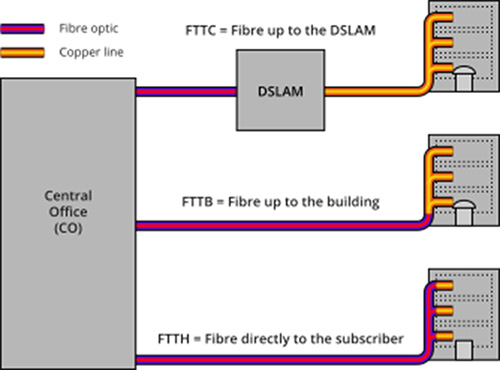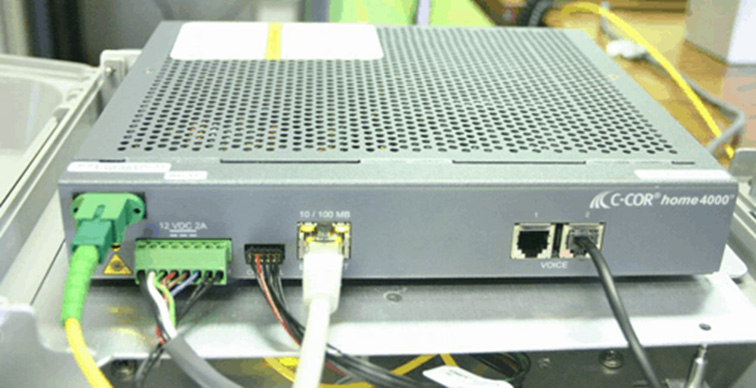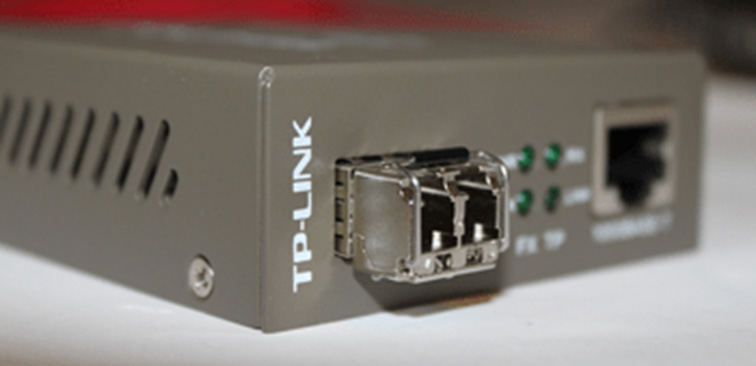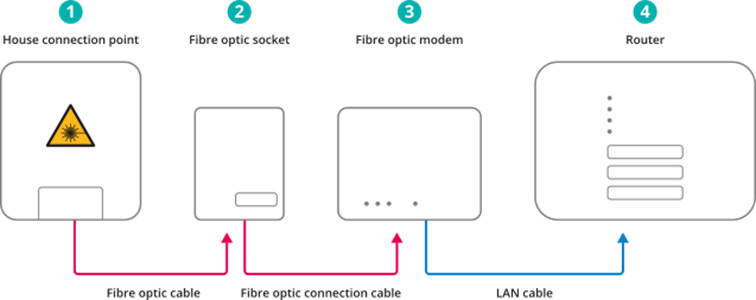
The original communication network was based on analogue data and implemented using copper cables. However, the progress of technology is becoming faster from time to time and the necessary transmission rates must increase accordingly. Nowadays, copper cables are gradually being replaced by modern fibre optic cables.
But what expansion stages are there at all? How will the fibre optic network be connected to an existing copper network? Which technologies can be realized by the new fibre optic network?
1 Which expansion stages of a fibre optic connection are available and what does FTTx mean?

Fig. 1: Forms of FTTx: FTTC, FTTB and FTTH
Based on an illustration by Riick~commonswiki, edited by Getsnoopy,
under the Creative Commons Attribution-Share Alike 3.0 Unported licence
In most cases, fibre optic networks are currently set up in such a way that they are routed by the relevant network operator from an exchange in the direction of the customer. Here various possibilities of how the fibre optic connection is distributed exist. The generic term for this is FTTx.
FTTX consists of the following expansion stages:
- FTTC (Fibre To The Curb)
- FTTB (Fibre To The Building)
- FTTH (Fibre To The Home)
1.1 What does FTTC mean?
FTTC is the term used to describe the extension with optical fibres up to the kerb (american: curb), where the optical fibre finally ends in a multi-functional cabinet. In addition, at this point the signals of the fibre optic technology are converted to copper cable up to the corresponding subscriber. This is also known as a hybrid network. The advantage here is that much greater bandwidths can be transmitted due to significantly shorter copper cables.
1.2 What does FTTB mean?
Here, optical fibres are routed into the building to a house transfer point. From this point, the existing copper cables are used again. This is also where the signal from the fibre optic cable is converted to the existing infrastructure.
1.3 What does FTTH mean?
With FTTH, the fibre optic line is laid up to the subscriber line in the subscriber’s home. Of course, not every customer will receive their own fibre optic cable from the central office. The copper line is exchanged or replaced by the cable splitter or multifunctional cabinet.
2 How can the fibre optic network be connected to the existing copper network?

Fig. 2: A multifunctional cabinet
Image by LSDL under the Creative Commons Attribution 2.0 Germany licence
In the first section, various stages of expansion of the fibre optic network were examined in more detail. Depending on the stage of expansion, the incoming fibre optic cable is connected to parts of the existing copper cable or is transferred directly to the apartment via modem.
2.1 What is a multifunctional cabinet?
Multifunctional cabinets are active cable distributors of a new generation. These new multifunctional cabinets are getting active technology closer to the customer. This shortens the route to the customer for data transmission via the poorer copper network and allows significantly higher bandwidths to be transmitted.
The connection between the incoming fibre optic cable and the continuing copper cable is made by a so-called optical network unit (ONU), which is located in a multifunctional cabinet of the network operator. Here the signals are converted for transmission to the subscriber on the existing copper line.

Fig. 3: Optical network unit (ONU)
Image by L_archi under the Creative Commons Attribution 1.0 generic licence

Fig. 4: Media converter with fibre SFP module
Image by Christophe Finot under the Creative Commons
Attribution-Share Alike 3.0 Unported licence
2.2 How does a media converter work?
Media converters are devices that are used in the network to convert signals of different transmission media. They are used to physically convert data to be transmitted from one medium to the other on various connecting cables, such as twisted pair cables, coaxial lines and optical fibres. In this way, for example, a greater transmission range can be achieved via a twisted-pair cable.
2.3 When is a fibre optic modem/router required?
For connections such as FTTC or FTTB, no special fibre optic modems are required. With these the conversion is done either in a multifunctional housing (FTTC) or directly at the house connection (1).
Fibre optic modems are required if, as with FTTH, the fibre optic cable is extended to the customer’s home. In this case, the fibre optic cable is routed from house connection point to the fibre optic socket (2) in the flat. The corresponding fibre optic modem (3) is then connected to this socket via a fibre optic cable. The router (4) is connected to this via a LAN cable. (See figure 5)

Fig. 5: Fibre optic modem
3 Which Internet technologies can be implemented in the various fibre optic expansion stages?
Due to constant expansion of the fibre optic network and various possibilities of FTTx connections, modern internet technologies can also be used. Two things in particular are worth mentioning here: On the one hand G.fast, on the other GPON. These two technologies are new and usually based on fibre optic networks.
3.1 What is G.fast?
G.fast is the latest DSL standard and the so called successor of VDSL2. With G.fast data rates in the gigabit range can be realized over very short distances. For transmission, G.fast uses much higher frequency ranges than VDSL2. The bandwidth for VDSL2 and supervectoring is 35 MHz, while G.fast uses 106 MHz or up to 212 Mhz. To achieve these bandwidths, the fibre optic network must be as close as possible to the customer. The most suitable options are FTTB (fibre to the house) or FTTH (fibre to the home).
| G.fast | 106 MHz | 500 Mbit/s | 500 Mbit/s | 250 m |
| G.fast | 212 MHz | 1000 Mbit/s | 1000 Mbit/s | 250 m |
Table 1: G.fast 106 MHz and 212 MHz im comparison
3.2 What is GPON and how does it work?
GPON is an optical transmission network to bridge large distances.
GPON (Gigabit Passive Optical Network) uses fibre optic cables instead of the copper cables used previously. With GPON, transfer rates of up to 2.5 Gbit/s downstream are possible, depending on the technology used. GPON is a so called shared medium technology: This means that the possible transmission rate is distributed to respective users. In order to do so, a splitter is used. This splitter distributes the incoming signal over 32 or 64 fibres, which are then forwarded to the customer. The interesting thing about this method is that the input signal of the splitter is distributed equally to all fibres. With GPON, the splitter is passive and does not require its own power supply – because of this, every user of these fibres gets the same data. The assignment of the data is done by an AES encryption. Because of this encryption, the receiver cannot decrypt the complete data stream at the input as it can only decrypt the requested data.

Fig. 6: GPON splitter and network structure
GPON and the data transmission can be realised via one or two fibres. If two fibres are used, one fibre is reserved for the downstream and one for the upstream. However, it is also possible to realise the downstream and the upstream via one fibre. In this case two different wavelengths of optical transmission are used. For the downstream the wavelength is 1490 nm, for the upstream it is 1310 nm.
Summary
The network structure is changing. Fibre optic cables can be laid up to the user in various expansion stages FTTx. The subscriber’s copper line, which is getting shorter and shorter, offers the use of modern Internet technologies such as G.fast or GPON and combines these with high download and upload speeds.




